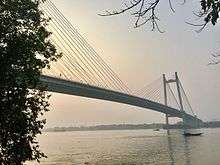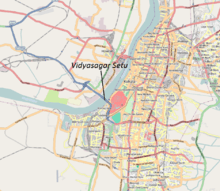Vidyasagar Setu
| Vidyasagar Setu | |
|---|---|
 Vidyasagar Setu at Sunset | |
| Coordinates | 22°33′25″N 88°19′40″E / 22.55694°N 88.32778°ECoordinates: 22°33′25″N 88°19′40″E / 22.55694°N 88.32778°E |
| Carries | Two-way with 3 general-purpose lanes in each direction |
| Crosses | Hooghly River |
| Locale | Kolkata, West Bengal |
| Official name | Vidyasagar Setu |
| Other name(s) | Second Hooghly Bridge |
| Maintained by | Hooghly River Bridge Commissioners |
| Characteristics | |
| Design | Cable-stayed bridge |
| Total length | 822.96 metres (2,700 ft) |
| Width | 35 metres (115 ft) |
| Longest span | 457.2 metres (1,500 ft) |
| Clearance below | 26 metres (85 ft) |
| History | |
| Constructed by | The Braithwaite Burn and Jessop Construction Company Limited |
| Opened | 10 October 1992 |
| Statistics | |
| Daily traffic | 45,000 - 61,000 vehicles (February 2008) |
| Toll | Yes, toll bridge |
 Vidyasagar Setu Location in West Bengal | |
Vidyasagar Setu (Bidyasagôr Setu), also known as the Second Hooghly Bridge (Dbitiyô Hugli Setu), is a toll bridge over the Hooghly River in West Bengal, India, linking the cities of Kolkata (previously known as Calcutta) and Howrah.
With a total length of 823 metres (2,700 ft), Vidyasagar Setu is the longest cable–stayed bridge in India. It was the second bridge to be built across the Hooghly River; the first, the Howrah Bridge (also known as Rabindra Setu) 3.7 kilometres (2.3 mi) to the north, was completed in 1943. Named after the educationist reformer Pandit Ishwar Chandra Vidyasagar, it cost ₹3.88 billion to build. The project was a joint effort between the public and private sectors, under the control of the Hooghly River Bridge Commissioners (HRBC).[1]
Initially, under the toll collection regime of the HRBC, daily traffic was recorded to be a minimum of 28,000 vehicles and a maximum of 39,000 vehicles in 2000, but fell to a maximum of around 30,000 vehicles by December 2002, when the management of the toll plaza was handed over to a private firm. Subsequently, the daily traffic reached a minimum of 45,000 vehicles and a maximum of 61,000 vehicles by early 2008, against a maximum capacity of 85,000 vehicles per day. The original management of the toll revenue collection by HRBC was consequently criticized for corruption and significant loss of revenue.[2]

History

Population and commercial activity grew rapidly after India gained independence in August 1947. The only link across the Hooghly River, the Howrah Bridge, between Howrah and Kolkata, was subject to much traffic congestion, with over 85,000 vehicles every day. This necessitated planning for a new bridge across the river so that it could connect to the major cities of Mumbai (Bombay), Delhi and Chennai (Madras) through the national highways located close to the bridge.[3]
The foundation stone for the bridge was laid by Indira Gandhi on 20 May 1972.[4] The bridge took more than 22 years to complete and cost Indian Rupees 3.88 billion,[3][5] but in seven of those years there was no construction activity.[3] The bridge is named after the 19th-century Bengali educationist reformer Pandit Ishwar Chandra Vidyasagar.[1][6] Work on the cable-stayed bridge started with the construction of the well curb on the Calcutta bank end on 3 July 1979.[7]
There are three other bridges on the Hooghly River connecting Kolkata with Howrah district: Vivekananda Setu built in 1932, (road-cum-rail bridge) – the first to be commissioned,[8] and which had become old and needed repairs; Howrah Bridge, a cantilever bridge commissioned in 1943, now renamed as Rabindra Setu (since 1965 in honour of the Noble Laurette Rabindranath Tagore);[9] and Nivedita Setu (named after Sister Nivedita), also known as the Second Vivekananda Setu, which is 50 metres (160 ft) downstream of the old Vivekananda Setu and was commissioned on 4 June 2007.[8][10] Kona Expressway and Vidyasagar Setu experienced an exponential rise in the volume of traffic over a couple of years. Over 100,000 vehicles take the expressway to reach Calcutta via Vidyasagar Setu. [11]
Construction


The bridge was designed by Schlaich Bergermann & Partner, and checked by Freeman Fox & Partners and Bharat Bhari Udyog Nigam Limited. Construction was carried out by the consortium of "The Braithwaite Burn and Jessop Construction Company Limited" (BBJ). The Hooghly River Bridge Commission (HRBC) was responsible for the commissioning operations of the bridge.[6][12][3]
Construction began on 3 July 1979, and the bridge was commissioned on 10 October 1992 by the Hooghly River Bridge Commission.[5][6][12]
Architectural features


Vidyasagar Setu is a cable-stayed bridge, with 121 cables in a fan arrangement, built using steel pylons 127.62 metres (418.7 ft) high.[12][3] With a total length of 823 metres (2,700 ft),[6] Vidyasagar Setu is the longest cable–stayed bridge in India.[6] The deck is made of composite steel-reinforced concrete with two carriageways. The total width of the bridge is 35 metres (115 ft), with 3 lanes in each direction and a 1.2 metres (3 ft 11 in)-wide footpath on each side. The deck over the main span is 457.20 metres (1,500.0 ft) long.[12] The two side spans are supported by parallel wire cables and are 182.88 metres (600.0 ft) long.[12][3] Vidyasagar Setu is a toll bridge. It has capacity to handle more than 85,000 vehicles in a day.[3]
The design of the bridge differs slightly from other bridges, which are of live load composite construction. The difference is in the dead load design concept adopted for this bridge and concreting of the side spans done with support provided by the intermediate trestle. The deck is designed with a grid structure of girders. One set of girders are at the end and another set in the middle, which are braced by girders spaced on an average at 4.2 metres (14 ft) centre to centre.[12]
A deck crane was used for the construction of the main span of the bridge. A specially designed crane of 45 tonne capacity was used to erect the pylons of the bridge.[12] The structural steel used in the bridge weighs about 13,200 tonnes.[12] The pylons, which are 128 metres (420 ft) in height, are designed as free standing portals.[12] They are provided with two cross portal members, one at the bottom and another at the top, below the pylon head. The deck is connected to the end piers by bolts embedded in the chambers of the piers. Pylons made of 4 m × 4 m (13 ft × 13 ft) steel boxes of riveted construction were raised on the two side spans of the bridge; one set is on the Calcutta side and the other is on the Howrah side.[12] The six pylons on the Calcutta side of the bridge were installed using 75 MT and 50 MT cranes, while on the Howrah end, a single 50 MT crane was used. Anchorage of the pylon with the base of piers was effected through Dywidag rods, duly anchored in the piers.[12] Cables were erected from the four pylon heads with the help of 32 MT hoist frames. The hoist frames were mounted on top of each pylon. Sheave blocks, winches and snatch blocks were used to facilitate the lifting, and cables inside the pylons were stressed with jacks. Pressure grouting was performed to fill the voids between the wire and the high-density polyethylene (HDPE) tubes. A two tonne tower crane, fixed inside the pylons, lifted the cables into position.[12]
The bridge has been subject to prototype wind tunnel tests at the Indian Institute of Science in Bangalore. Bearings are used in vertical and horizontal directions, with grouted collars in four segments at the two end piers and horizontal bearings at the two middle piers to achieve stability against lateral movement. Maurer Söhne expansion joints were provided to allow for 400 millimetres (16 in) horizontal expansion at the free ends.[12] Fixed end slab seal type expansion joints 115 millimetres (4.5 in) were used for horizontal expansion of the joints.[12] Other essential components provided in the bridge structure are the handrails, lightning arresters, crash barriers, gas service support structures, telephone and electric lines, lifts in the pylons, and a maintenance gantry.[12]
Post-construction Scenario
Over the years, several accidents have occurred on the bridge resulting in traffic congestion, and sometimes closure of the bridge for a few hours.[13] To relieve the heavy traffic congestion at the entry to the bridge, the Hooghly River Bridge Commissioners (HRBC) plan to build two one-way-exit and entry–ramps. These are planned with a semi-circular layout in the form of side wings, which will facilitate easy flow of traffic, before the toll plaza, on roads leading to the Howrah railway station.[13] There are also plans to improve the lighting on the bridge by installing LED lamps and search lights covering the four pylons, the bridge spans, cables and under-deck. An electronic toll collection system was scheduled to be introduced by 2014, to help improve the flow of traffic across the bridge.[13]
The traffic projections for the bridge at the planning stage have not been achieved. A traffic survey carried out for a week during June 2012 recorded traffic of 29,000 vehicles over the bridge in comparison to a projected 85,000. A survey conducted during the same period in June 2012 indicated a figure of 31,865 vehicles, though it is reported by the concerned traffic and transportation engineer that the rate of increase in traffic has been one percent per year on the basis of traffic surveys carried out from the time of commissioning of the bridge. The reason for the fall in traffic during 2012 is attributed to the peak monsoon effect during the survey period.[13]

See also
- List of largest cable-stayed bridges
- List of longest bridges in the world
- List of longest bridges above water in India
References
- 1 2 "History". Kolkata Port Trust: Government of India. Retrieved 8 February 2011.
- ↑ "Toll". The Times of India. Retrieved December 20, 2014.
- 1 2 3 4 5 6 7 "Vidyasagar setu". Shibpur International website. Retrieved 8 February 2011.
- ↑ Bhattacherje 2009, p. 242
- 1 2 Bhattacherje 2009, p. 273
- 1 2 3 4 5 "Vidyasagar Setu". Official Website of Hooghly River Bridge Commissioners. Retrieved 8 January 2013.
- ↑ Bhattacherje 2009, p. 252
- 1 2 "Design and Construction Features of Nivedita Bridge". NBM Construction Information. Com.
- ↑ "Oldest still the busiest". Official web site of Howrah Bridge Kolkata managed by National Informatics Centre.
- ↑ "The Nivedita Setu". The Hindu Business Line. Retrieved 5 January 2013.
- ↑ http://www.telegraphindia.com/1160119/jsp/calcutta/story_64629.jsp#.V-TuY5eP9Jg
- 1 2 3 4 5 6 7 8 9 10 11 12 13 14 15 Gunguly & Battarcharya 2000, pp. 113–4.
- 1 2 3 4 "Vidyasagar Setu ramps to decongest traffic". The Times of India. 28 June 2012. Retrieved 5 January 2013.
Bibliography
- Gunguly, C. K.; Battarcharya, S. K. (2000). Dayaratnam, P, ed. The Design Methodology and Construction Technique of 457 m Span Cable Stayed Bridge (Dead Load Composite) at Vidyasagar Setu. Cable stayed, supported, and suspension bridges. Universities Press (India). pp. 113–4. ISBN 978-81-7371-271-5.
- Bhattacherje, S. B. (2009). Encyclopaedia of Indian Events & Dates. Sterling Publishers Pvt. ISBN 978-81-207-4074-7.
External links
| Wikimedia Commons has media related to Vidyasagar Setu. |
- The pictures of the bridge and its surroundings